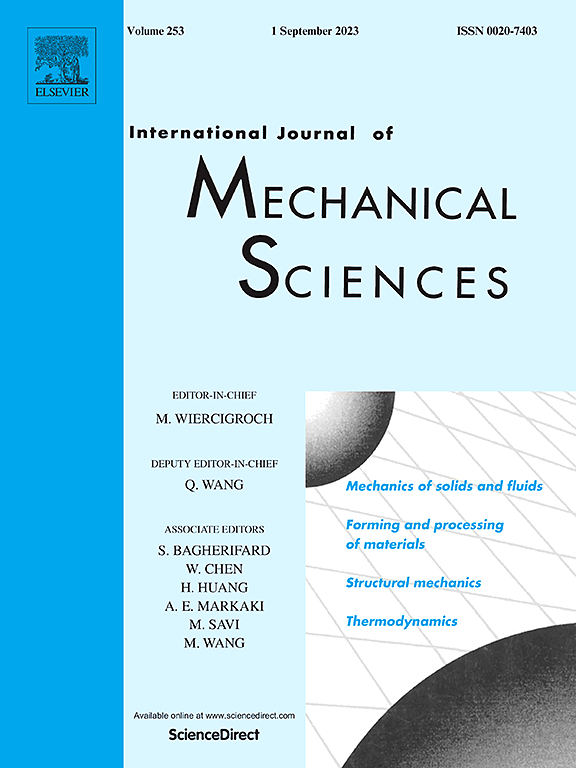Mechanical properties of template-based 3D graphene foams via multiscale modeling
IF 7.1
1区 工程技术
Q1 ENGINEERING, MECHANICAL
International Journal of Mechanical Sciences
Pub Date : 2025-07-19
DOI:10.1016/j.ijmecsci.2025.110621
引用次数: 0
Abstract
Nanoporous graphene foams fabricated via template-based chemical vapor deposition (CVD) exhibit excellent tensile properties, including self-stiffening modulus, ductile fracture behavior, and exceptional damage tolerance at ultra-low densities, making them highly promising flexible electronics. However, the underlying mechanisms behind these properties remain unclear. Here, we propose an innovative approach to constructing template-based 3D graphene models by integrating computational algorithms to simulate the synthesis process and resulting structural morphology. Molecular dynamics (MD) and finite element (FE) simulations are then employed to analyze the tensile and compressive properties of the obtained 3D graphene foams. Additionally, scaling laws are derived to describe the relationship between mechanical properties and relative density, validated against experimental CVD data, confirming the accuracy and validity of this work. Finally, we conduct a detailed quantitative analysis of the microstructural mechanisms driving self-stiffening and the transition from brittle to ductile fracture. This study offers valuable insights into the deformation mechanisms and energy absorption characteristics of template-based 3D graphene, enhancing our understanding of the structure-property relationships and expanding its potential applications.基于模板的三维石墨烯泡沫力学性能的多尺度建模
通过基于模板的化学气相沉积(CVD)制备的纳米多孔石墨烯泡沫具有优异的拉伸性能,包括自强化模量、韧性断裂行为和超低密度下的优异损伤容限,使其成为非常有前途的柔性电子产品。然而,这些特性背后的潜在机制尚不清楚。在这里,我们提出了一种创新的方法来构建基于模板的3D石墨烯模型,通过集成计算算法来模拟合成过程和产生的结构形态。然后采用分子动力学(MD)和有限元(FE)模拟分析了所获得的三维石墨烯泡沫的拉伸和压缩性能。此外,导出了描述力学性能与相对密度之间关系的标度定律,并与实验CVD数据进行了验证,证实了本工作的准确性和有效性。最后,我们进行了详细的定量分析微观组织机制驱动的自加强和从脆性到韧性的转变断裂。这项研究为基于模板的3D石墨烯的变形机制和能量吸收特性提供了有价值的见解,增强了我们对结构-性能关系的理解,并扩大了其潜在的应用。
本文章由计算机程序翻译,如有差异,请以英文原文为准。
求助全文
约1分钟内获得全文
求助全文
来源期刊

International Journal of Mechanical Sciences
工程技术-工程:机械
CiteScore
12.80
自引率
17.80%
发文量
769
审稿时长
19 days
期刊介绍:
The International Journal of Mechanical Sciences (IJMS) serves as a global platform for the publication and dissemination of original research that contributes to a deeper scientific understanding of the fundamental disciplines within mechanical, civil, and material engineering.
The primary focus of IJMS is to showcase innovative and ground-breaking work that utilizes analytical and computational modeling techniques, such as Finite Element Method (FEM), Boundary Element Method (BEM), and mesh-free methods, among others. These modeling methods are applied to diverse fields including rigid-body mechanics (e.g., dynamics, vibration, stability), structural mechanics, metal forming, advanced materials (e.g., metals, composites, cellular, smart) behavior and applications, impact mechanics, strain localization, and other nonlinear effects (e.g., large deflections, plasticity, fracture).
Additionally, IJMS covers the realms of fluid mechanics (both external and internal flows), tribology, thermodynamics, and materials processing. These subjects collectively form the core of the journal's content.
In summary, IJMS provides a prestigious platform for researchers to present their original contributions, shedding light on analytical and computational modeling methods in various areas of mechanical engineering, as well as exploring the behavior and application of advanced materials, fluid mechanics, thermodynamics, and materials processing.
 求助内容:
求助内容: 应助结果提醒方式:
应助结果提醒方式:


